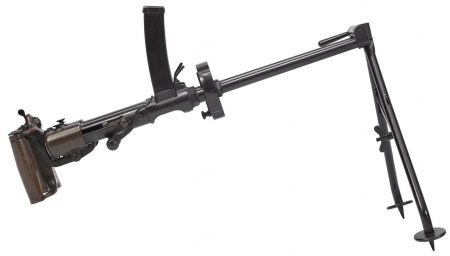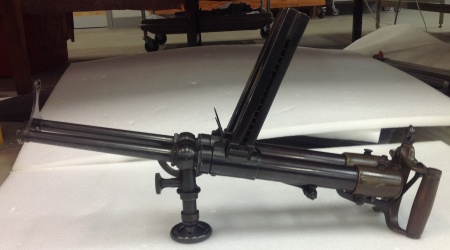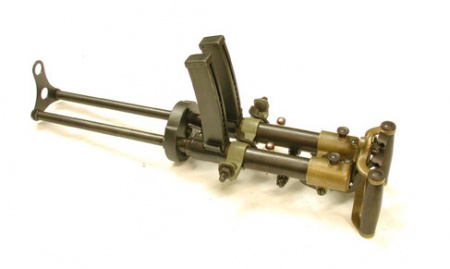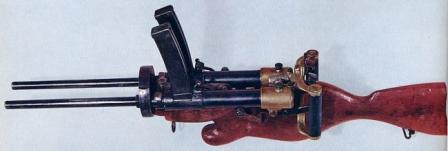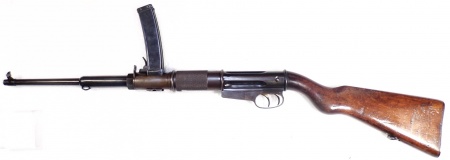| If you have been locked out of your account you can request a password reset here. |
Villar Perosa M1915
The Fiat Mod. 1915, better known as the "Villar Perosa", is an Italian twin-barreled submachine gun that was developed in 1915 by Bethel-Abiel Revelli and manufactured by Officine di Villar Perosa (from which the gun derives its popular nickname). Consisting of two tubular receivers tethered together, with independent actions and triggers, the weapon was chambered for the 9x19mm Glisenti cartridge - a highly unusual choice of cartridge for a machine gun at the time - and was fed from two 25-round curved box magazines, firing at a rate of about 1,500rpm per barrel (c.3,000rpm combined). The Villar Perosa was adopted by the Italian Army during World War I, and was the first pistol-caliber machine gun to ever see military service, though there is some contention as to whether it can truly be classified as a submachine gun, as it was originally fielded in the role of a crew-served light machine gun. With the establishment of the Arditi corps in 1917, the Villar Perosa began to be fielded as an assault weapon for clearing trenches, and was sometimes worn around the user's neck by a strap so that they could operate the weapon from a mobile stance. Some guns were also issued to the Corpo Aeronautico Militare to be fitted as auxiliary weapons on aircraft, though contrary to popular belief, it was not intended to be used exclusively as an aircraft gun.
The Villar Perosa was made in two different configurations: an infantry type and and an aerial type. The infantry guns are instantly distinguishable by their disc-shaped barrel clamp, which was intended to act as a connecting point for a shield mount. Later in the war, the shield mount was replaced with a light bipod, though the disc clamp was retained. The aerial guns, on the other hand, were typically built with a flexible pintle mount and a pair of elevated sights. Additionally, a small number of Austro-Hungarian copies of the Villar Perosa, known as the Sturmpistole ("Assault Pistol"), were made during the war in the 9x23mm Steyr cartridge; these are identifiable by their straight magazines and are mounted to flat wooden trays.
Two single-barreled derivatives of the Villar Perosa were produced towards the end of World War I: the OVP and the Revelli-Beretta. These were both adopted by the Italian Army in limited quantities. Production of the Villar Perosa and its variants ceased upon the end of the war, and the weapon was quickly made obsolete from Italian service when more conventional submachine guns and light machine guns became available.
Because of the scarce availability of the Villar Perosa outside of museums today, some movie productions have made Villar Perosa mock-ups from later Beretta submachine guns.
Villar Perosa SMG and variants can be seen in the following films, television series, video games, and anime used by the following actors:
Villar Perosa
Specifications
(1915 – 1918)
- Type: Submachine gun/Light machine gun
- Calibers: 9x19mm Glisenti, 9x23mm Steyr (Austro-Hungarian copy), .455 Webley Auto (British trials model)
- Weight: 14lb (6.5 kg) (sans mount)
- Length: 35 in (900 mm)
- Barrel length: 11 in (279 mm)
- Capacity: 2 x 25 rounds
- Fire Modes: Full-Auto only
Video Games
| Game Title | Appears as | Mods | Release Date |
|---|---|---|---|
| Battlefield: 1918 | "Villar-Perosa" | Early pattern version | 2010 |
| Isonzo | "Villar Perosa 9 mm Mo.15" | Late pattern version | 2022 |
OVP
The OVP was developed by Bethel-Abiel Revelli in 1917 and produced by Officine di Villar Perosa as a variation of the Villar Perosa, taking the form of a single-barreled stocked carbine rather than a twin-barreled mounted weapon. It was intended as a collapsible takedown gun for pilots, featuring a detachable wooden buttstock that allowed it to be compacted inside the cockpit of a plane. The firing mechanism, chambering, and magazines were identical to that of the Villar Perosa, but the components were mostly made from scratch and were not recycled from existing examples of the Villar Perosa.
Built with a twin trigger group permitting fully-automatic fire and single shots, the OVP was one of the earliest "true" submachine guns ever made, and was adopted for service with the Corpo Aernautico Militare in 1918. It was not, however, issued as an infantry weapon, a role that would instead be filled by the later Revelli-Beretta carbine.
Specifications
(1917 - 1918)
- Type: Submachine gun
- Caliber: 9x19mm Glisenti
- Weight: 8.09lb (3.67 kg)
- Length: 35.43 in (900 mm)
- Barrel length: 11.02 in (280 mm)
- Capacity: 25 rounds
- Fire Modes: Semi-Auto/Full-Auto
Video Games
| Game Title | Appears as | Mods | Release Date |
|---|---|---|---|
| Sniper Elite 4 | "OVP M1918" | 2017 | |
| Strange Brigade | "Chamberlain Automatic Rifle" | with a 35 round magazine | 2018 |
| Enlisted | "OVP M1918" | 2021 |
Revelli-Beretta
The Revelli-Beretta, frequently called the "Beretta M1918" in modern sources, was a conversion of the Villar Perosa into a single-barreled, stocked carbine with a reworked trigger, designed to allow the weapon to be fired from the shoulder rather than from a mount. This gun was designed at Beretta under the direction of Bethel-Abiel Revelli and was adopted by the Italian Army in September 1918, with the intended goal of converting most of their Villar Perosas into Revelli-Beretta carbines. However, the armistice was signed before this could be achieved, and only a few thousand examples are thought to have actually been made. Although a small number were delivered to the Italian Army for issue, there is no evidence that they ever saw active combat use before the end of the war. Most were later relegated to issue with Italian colonial troops in the 1920s and some were sold off as surplus to Ethiopia.
Although typically described as a submachine gun in many sources, with some even going so far as to call it the "first submachine gun", the Revelli-Beretta was in fact a semi-automatic carbine with no selective-fire capability. Experimental prototypes were made with fully-automatic function, but the fire rate proved to be too excessive, and the production model therefore was made to fire single shots only. Thus the Revelli-Beretta has little claim to being one of the earliest service SMGs.
The Beretta M1918/30 is commonly claimed to be a post-war improvement of the Revelli-Beretta, though the two guns were not actually related beyond sharing the same furniture.
Specifications
(1918)
- Type: Carbine
- Calibers: 9x19mm Glisenti
- Weight: 7lb 3oz (3.3 kg)
- Length: 43 in (1092 mm)
- Barrel length: 12in (305 mm)
- Capacity: 25 rounds
- Fire Modes: Semi-auto
Video Games
| Game Title | Appears as | Mods | Notations | Release Date |
|---|---|---|---|---|
| Battle of Empires: 1914-1918 | "Beretta 1918" | 2015 | ||
| Battlefield 1 | "Automatico M1918" | Depicted as a full-auto submachine gun | 2016 | |
| Enlisted | "Beretta M1918" | Depicted as a full-auto submachine gun | 2021 |
